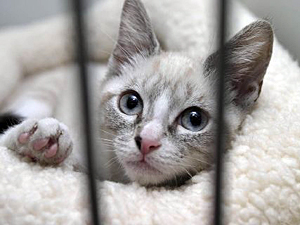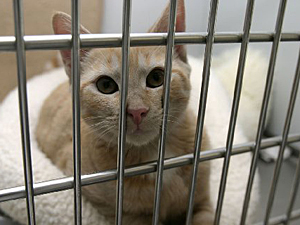
Many precious kittens were available for adoption at the Mayor's Alliance/Maddie's Pet Adoption Festival in Central Park, where Carole provided advice about cats.
Photo by Rick Edwards
Notes from the Cat Therapist
September 23 was a terrific day for the Mayor's Alliance/Maddie's Adoption Festival in Central Park. The rescue groups and shelters were there with cat, dog and even bunny adoptees. An upbeat, jovial spirit filled the air and was highly contagious. I shared a tent with two TTouch practitioners, Mary Bruce and Peggy Marks, whose company made the energy very positive for me to talk to attendees about cat therapy.
One of the attendees, Renee, had worked for me back in the 1970s, when Dr. Paul Rowan and I had The Cat Practice in the West Village. It was the very first veterinary hospital for cats in Manhattan. When we opened, my raison d'être was to help cats, to make them feel better, and I would pass on my behavioral observations to Dr. Rowan. But as the practice grew busier and busier, he said I should convey my behavioral recommendations directly to our clients — which I did. In the '70s, cat behavior therapy was not a well-known commodity. We soon realized that my specialty needed a "handle" for clients to grasp, so I referred to myself as a "feline therapist." The media kept referring to me as the "cat shrink," and this led to my calling myself "The Cat Therapist," which stuck. Since then, dog, bird, and many other therapies have evolved. I've been told that my work has been a great springboard to the veterinary profession. I'm very grateful that my desire to help cats has manifested in these other areas, as well.
By the time we left The Cat Practice, I had written two books on cat behavior and was being called "the kitty Freud" and "the founding mother of feline psychotherapy." It was there that I began working out ways to correct and prevent cat behavior problems. I was able to create and develop my techniques for introducing new kittens, dogs, and babies; how to treat attack cats and feral cats; and other problems. I call these methods "The Wilbourn Way" for understanding your cat's emotions and communication signals.
I soon started making house calls to cats with behavioral issues, doing phone consultations, writing a column for Cat Fancy, seeing appointments at Westside Veterinary Center (where I am still in residence), joined the board of the The Humane Society of New York, and was instrumental in starting companion animal (pet) therapy at St. Vincent's Hospital. National Geographic referred to my cat practice as "bi-species," because I must be able to successfully communicate with the cat's guardian in order to help the cat.
Renee is now long-married, has three rescue cats and a dog, and helps out with the graphics for Rational Animal. I told her how I now had a Q&A column for In Defense Of Animals and how she should enter her senior cat in The Fabulous 13 and Older Cat Contest.

Cats who live alone or as "third wheels" in a three-cat household may develop unwanted behaviors out of boredom or frustration.
Photo by Rick Edwards
As Renee went on her way, a gentleman on his bicycle stopped by. He told me how his big, athletic, one-year-old, neutered cat had started splashing most of the water out of the water bowl. He'd solved that problem by placing the bowl in the bathtub and adding a second one. His other two cats were seniors and never were particularly playful or friendly with his younger cat. I told him that this behavior had shades of "Single Cat Syndrome" because, although his younger cat had older companions, he was left out of the loop. It was definitely characteristic of the "Triangle Syndrome," where he was the third cat out. His "aqua therapy" was a creative way of having fun instead of yielding to frustration. I recommended that he might use a laser light to inspire his three cats to react and chase or at least follow the rays of the light. Perhaps some catnip would give the older ones an energy spurt.
I also suggested that his youngster might like some dog energy. If a neighbor had a cat-friendly dog, perhaps play dates could be arranged. His guardian mentioned how his younger cat hung out at the windows. "You might check out a kitty porch that could be attached to the window," I said, or take him for a stroll outdoors and pointed to the Stroller, which my friends at KittyWalk donated to the Mayor's Alliance as a raffle prize for the event. "You could take him outdoors on a kitty harness at a quiet time of day in a secluded area, but first get him comfortable with the harness indoors before the outing," I added. He thanked me for my recommendations and mentioned what a great event this was. "I must admit I am tempted to adopt a kitten to even out my family, but not today."
Another guardian stopped by to tell me how she'd enjoyed my books. She realized that her longhaired cat might be grouchy because of his tangles. A modified "lion cut" was the solution, and his grouchiness quickly faded.
"Thanks for your recommendation to adopt a very cat-oriented or feral kitten for my aggressive male. We are now a very happy family," another young lady told me. I have found that feral kittens or cats are often the solution for a cat who needs feline company but doesn't want to share his/her people's attention. This has been a wonderful way to solve attack-cat behavior and other psychological problems such as over-grooming (alopecia nervosa).
By the end of the afternoon I had spoken with many attendees and the spirit of the gala occasion was still going strong with the Wilbourn Way team. I look forward to the next Mayor's Alliance adoption event. I hope I'll see you there.
For more than 30 years, Carole Wilbourn has consulted with veterinarians to devise "The Wilbourn Way" — logical, easily implemented methods for preventing and/or correcting common feline emotional and psychological problems. Also known as "the kitty Freud" and "the founding mother of cat psychology," Carole has published five books on cat psychotherapy and logged more than 100,000 miles making house calls to patients throughout the world. Carole wrote a monthly column, "Cats on the Couch," for Cat Fancy magazine for 16 years, and is currently a columnist for In Defense of Animals. She gives seminars at The Open Center and 92nd Street Y in Manhattan as well as The Learning Annex in Toronto. In addition, Carole is a staff consultant and sees clients at Westside Veterinary Center in New York City. In 1972, she co-founded The Cat Practice, the first veterinary hospital in New York City exclusively devoted to cat care.
You can learn more about Carole's background and work, find free behavior advice, read about her books and new Caring for Your Cat, The Wilbourn Way CD, and subscribe to receive her free monthly newsletters by visiting her website, TheCatTherapist.com.







